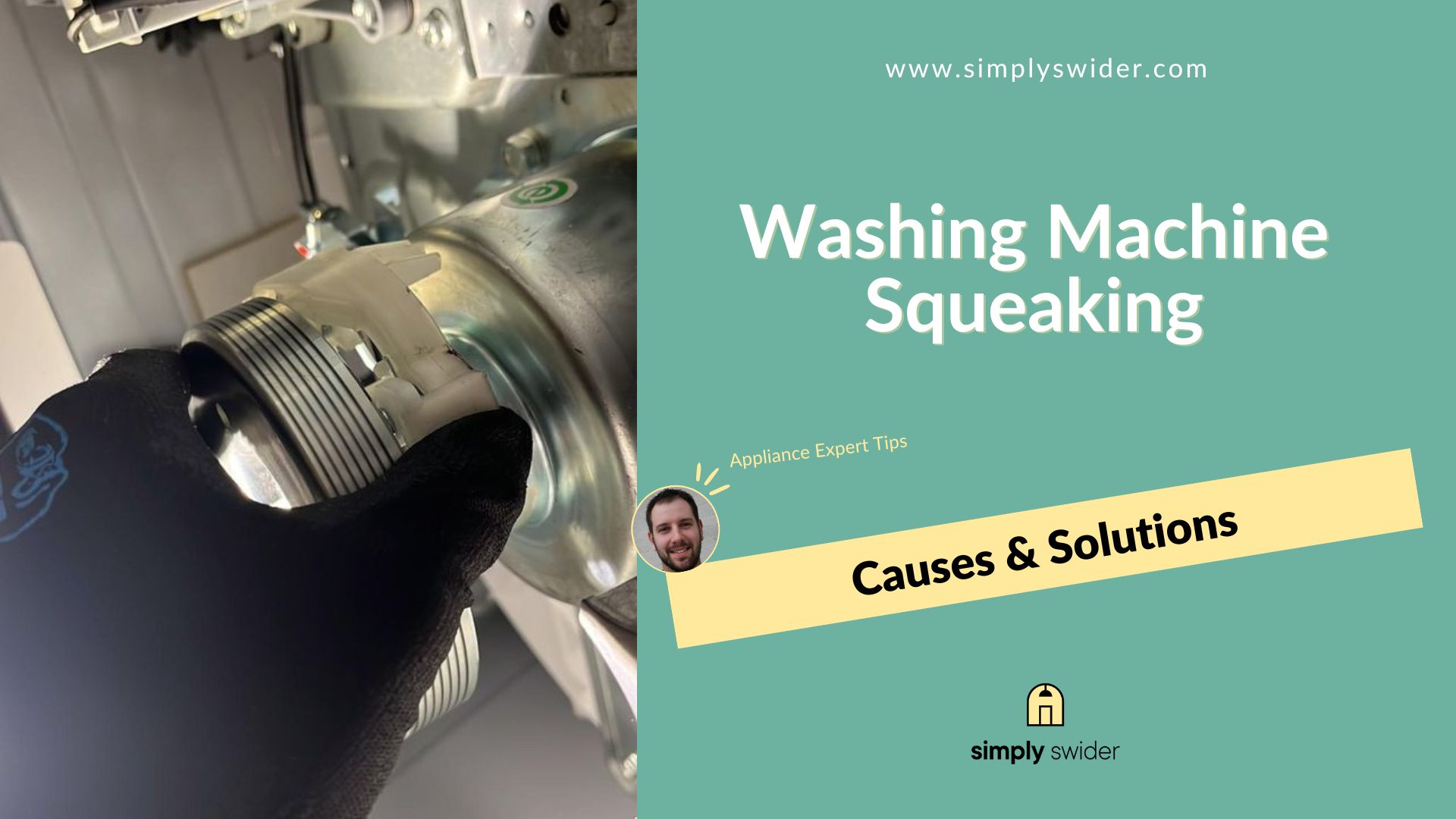Trust me, I get it.
A washing machine should sound like a well-oiled machine, not a squeaky wheel. In my years of fixing appliances, few sounds have irked homeowners more than a washing machine squeaking mid-cycle. It’s like nails on a chalkboard.
Here’s the deal:
I’ve teamed up with Jake Anderson, a top-tier appliance repair tech from Richmond, VA, to get to the bottom of this. Together, we’re going to troubleshoot what’s behind that grating noise and give you the tools to fix it.
So, if you’re tired of your washing machine auditioning for a horror film, keep reading. Let’s silence that squeak once and for all.

Table of Contents
Why Is My Washing Machine Making a Squeaking Sound?
I’ve spent years fine-tuning washing machines, and trust me, that squeak you hear isn’t uncommon. Most times, it’s the drive belt acting up. But it could also be a loose rotor, a clogged drain pump, or even a faulty transmission. Then there are the minor causes like something caught between the tubs or a machine that’s not level.
Let’s dive in:
Before we venture into the labyrinth of squeaks, I always begin with what I’ve fondly termed, “Noise 101.” A series of diagnostic questions designed to zoom in on the source.
Good news:
I’m handing over my trusted checklist, a tool I’ve employed on countless occasions, whether it’s an LG, Samsung, or even a Whirlpool washer.
| Washer Noise 101 | |
|---|---|
| 1. When is the noise occurring? | During water fill? |
| During agitation? | |
| While spinning? | |
| During drainage? | |
| 2. Where is the noise coming from? | Back? |
| Front? | |
| Bottom? | |
| Middle area? | |
| 3. Can you manually trigger the noise? | E.g., If it’s below the tub, move the tub. |
| 4. Any burning smell? | Squeak plus a smell could be a damaged belt. |
| 5. Character of the noise? | Rubber against rubber? |
| Rubber against metal? | |
| Metal against metal? | |
| A bearing sound? | |
| 6. Oil leak at the bottom? | Sign of a damaged transmission. |
| 7. Noise during an empty load? | Run a quick cycle with the washer empty. |
| 8. Sound like a foreign object? | Could be a coin or other object. |
Jake, a colleague, once shared this gem:
“Remove the agitator or pulsator. Initiate a brief wash cycle. Listen. If the squeak vanishes, your agitator might be the culprit.”
With these basics covered:
Let’s delve deeper into what might be causing your washer to sound its mysterious squeak.
8 Experienced Insights into the Causes and Solutions for a Squeaking Washing Machine
| Commonly Affected Parts | Estimated Cost |
|---|---|
| Drive belt | $10-$50 |
| Splutch Cam Kit | $10-$50 |
| Drain pump | $50-$200 |
| Transmission | $200-$500 |
| Tub seal | $5-$30 |
| Rotor | $100-$200 |
| Agitator repair kit | $10-$50 |
| Motor coupling | $10-$50 |
| Clutch | $20-$100 |
| Suspension rods and springs | $20-$100 |
1. Damaged Drive Belt or Broken Splatch Kit Cam
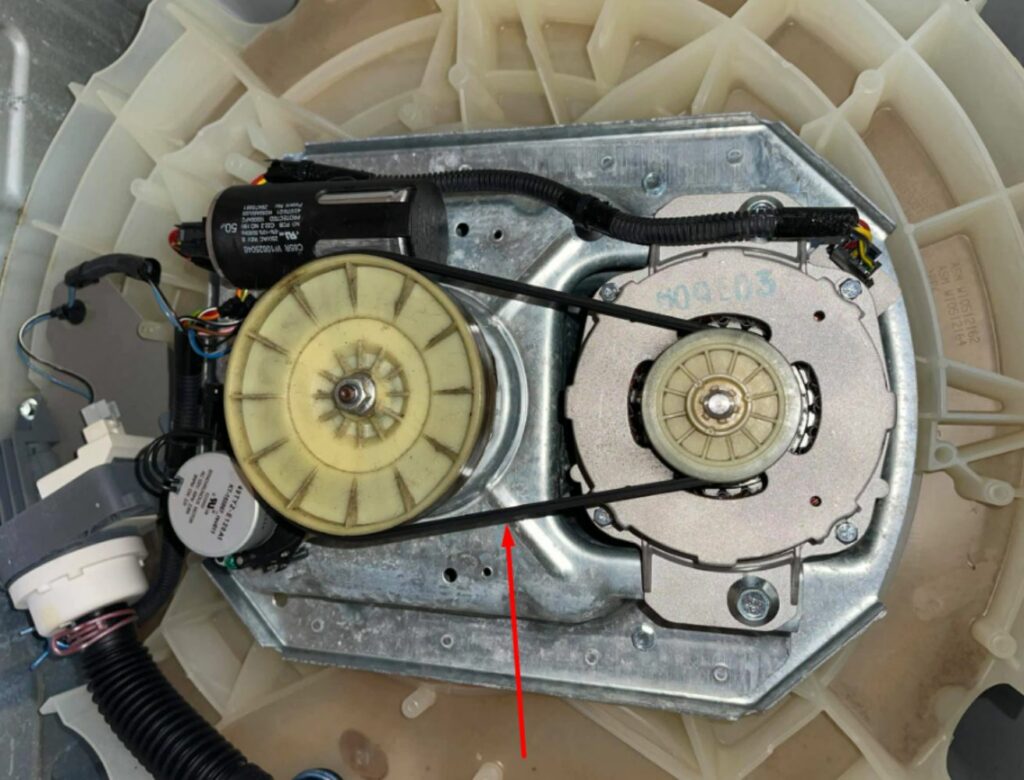
| Parts | Drive belt |
| Splutch cam kit | |
| Location | Bottom of the washer |
| Ease of troubleshooting | Medium |
| Replacement cost – Drive belt – Splutch cam kit | $10-$50 $10-$50 |
| Repairable | No |
Problem:
Let’s be real:
If there were an awards ceremony for “Hardest Worker” washer parts, the drive belt would be vying for top honors.
As Jake explains, “This unsung hero is usually located at the bottom (top-load) or back (front-load), and it’s used to transfer power from the motor to the drum.”
However:
Over time, the drive belt can become aged, frayed, or cracked, leading to irregular movements and squeaking sounds.
That’s not all:
Sometimes, a small object or debris can get lodged on the belt or pulley, causing it to squeak as it moves.
Jake chimes in, “My most recent fix involved a GE washer where the belt was misaligned with the motor and drum pulleys.”
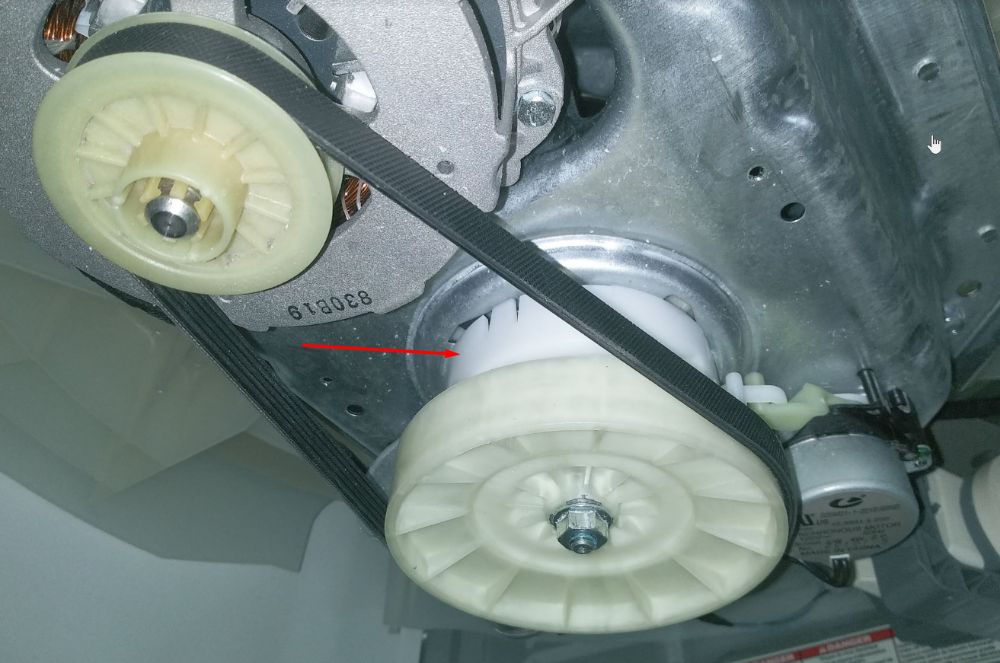
Plot twist:
Sometimes, the culprit isn’t actually the drive belt, but its sidekick, the splutch kit, like with this Whirlpool WTW4816FW2 washer.
The splutch kit is the white, round plastic piece that sits below the bigger motor pulley.
It’s role?
To help the washer shift between different modes, like moving from agitation to spinning.
However:
The splutch cam assembly can wear down, leading to metal-on-metal contact or excessive friction, which can cause a squeaking noise.
Luckily:
The drive belt and splutch cam are inexpensive and easy to inspect and replace.
Identification:
For top-load washers, the two components are located at the bottom.
So:
To get a good look, you’ll have to tip the washer onto its back.
But before that:
Safety first—Unplug the washer from the power outlet and turn off the water supply.
Step-by-step on how to inspect the belt drive and splutch kit assembly.
- Step 1: Unscrew the belt cover.
For household names like Maytag, Whirlpool, Amana, and Kenmore, you’ll need a 5/16 nut driver.
After that:
Inspect the sides of the cover to see if the belt has been brushing against the cover.

- Step 2: Remove the shift actuator.
- Step 3: Next, inspect the belt tension, as a loose belt can cause a squeaking sound.
Secondly, look at the belt for signs of fraying, cracks, or other wear and tear.
- Step 4: Remove the motor pulley to access the splutch cam.

- Step 5: Detach the splutch cam and inspect it.
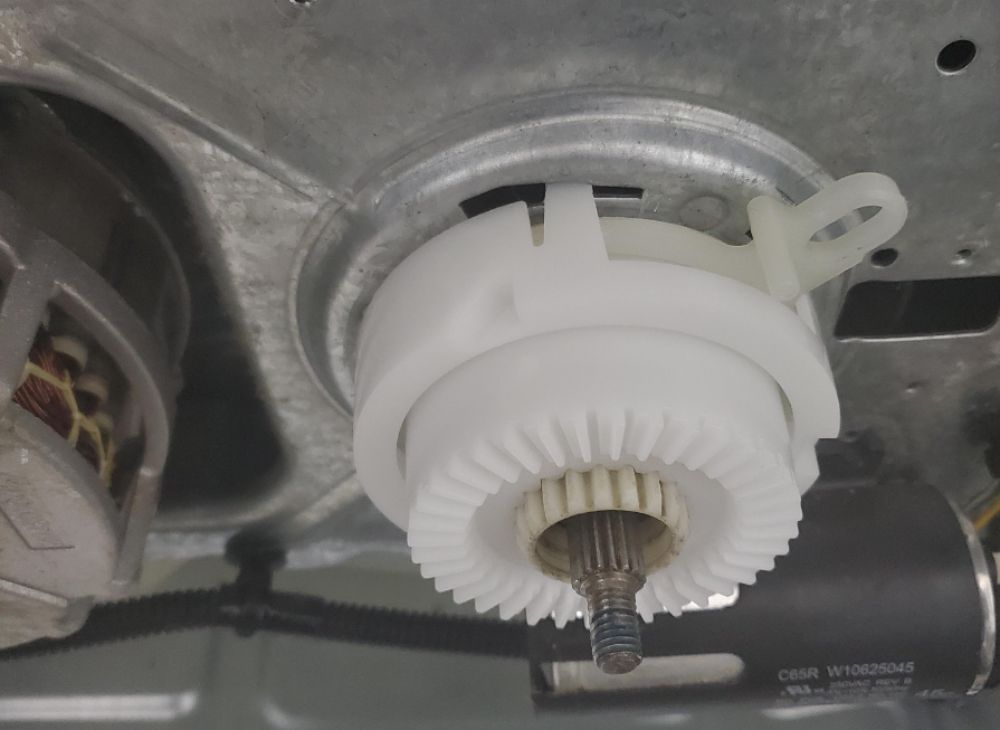
Note:
This process will be different for front-load washers such as the Frigidaire FWT449GFS2 and the GE Washer WH03X29522 since the belt is located at the back.
Solution:
Now:
If the belt has seen better days, swap it out and see if that quiets things down.
For instance, this technician found the belt stretched on his Whirlpool top load washer.
However:
If there is debris lodged on the belt or residuals on the pulleys, use a brush and a damp cloth to wipe them clean.
On the other hand:
If it turns out that the splutch cam is the culprit, replace it, similar to what this guy did with his chirping Amana WTW4816FW2 Washer.
2. Foreign Object in the Drain Pump
| Part | Drain pump |
| Location | Bottom of the washer |
| Ease of troubleshooting | Medium |
| Replacement cost | $50-$200 Mostly, no replacement is needed. |
| Repairable | Yes |
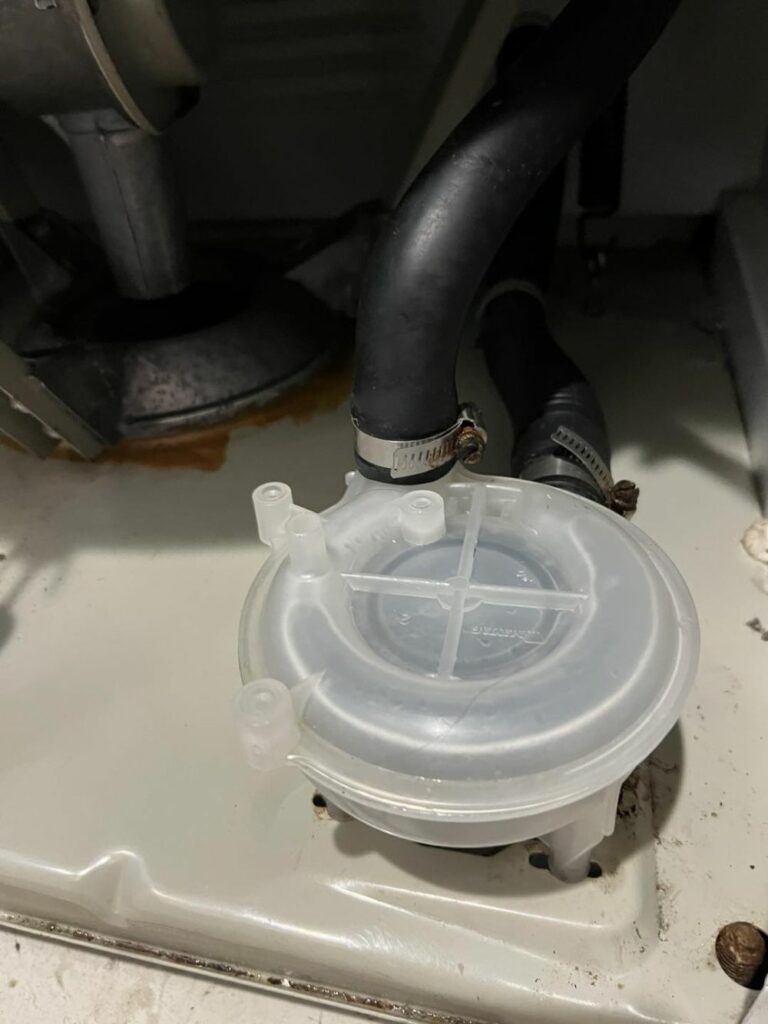
Problem:
We’ve all been there.
You forget to empty your pockets, and a coin or some other trinket makes an escape into the washer.
Now:
As the washer goes through its cycles, these items can dislodge from the pockets into the tub.
As Jake rightly puts it…
“While most stray coins mostly end up below the agitator/pulsator or in the drain filter, sometimes they end up getting inside the drain pump.”
Result?
As the drain pump operates, the foreign object can get caught in the pump’s impeller, causing a grinding or squeaking noise due to increased friction.
Identification and solution:
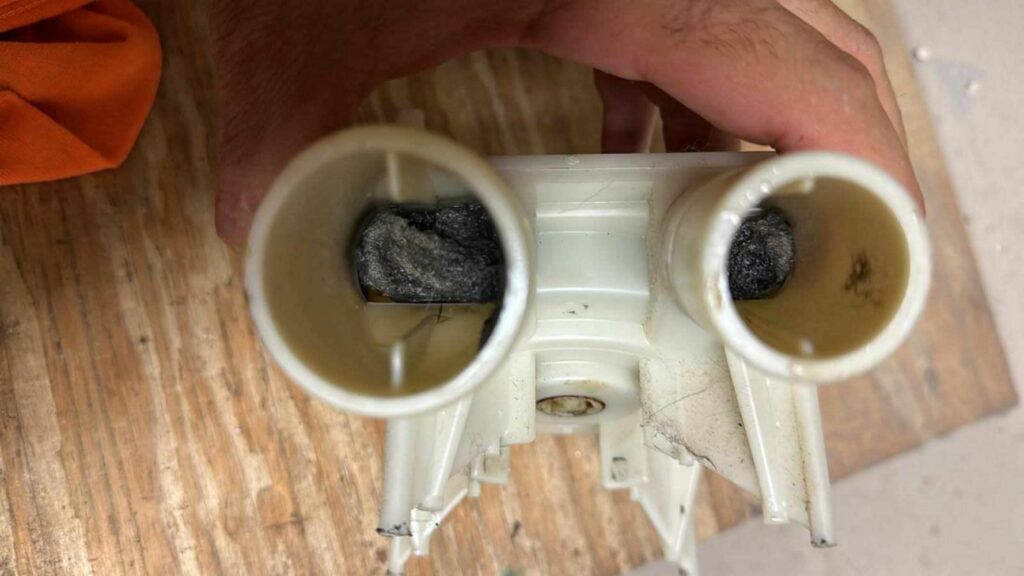
The first thing to do is examine the noise closely.
How?
If the squeaking occurs primarily during the drain cycle, that is a sign that the drain pump could be the issue.
Next:
Locate the drain pump. Usually, it’s located at the bottom of the machine.
Pop it open and check if there is anything inside, and clean it up.
3. Transmission or Tub Seal
| Part | Transmission Tub seal |
| Location | Beneath the tub |
| Ease of troubleshooting | Hard |
| Replacement cost | Transmission – $200-$500 Tub seal – $5-$30 |
| Repairable | Transmission – Yes Tub seal – No |
Problem:
The next culprit is what I dub “the bad news bearer.” It’s often a pricier fix that might have you contemplating a new washer altogether.
Luckily:
Sometimes, it’s fixable and could even be a warranty job.
As Jake explains,
“The transmission is the gearbox that dictates the movement patterns of the washer. For top-load washers, it’s connected to the motor via the drive belt.”
Now:
Inside the transmission assembly, there are sets of gears and bearings that facilitate the movements.
However:
“Over time, they can wear out due to use and a lack of proper lubrication in the factory,” Jake continues.
There have been several bulletins released regarding this issue.
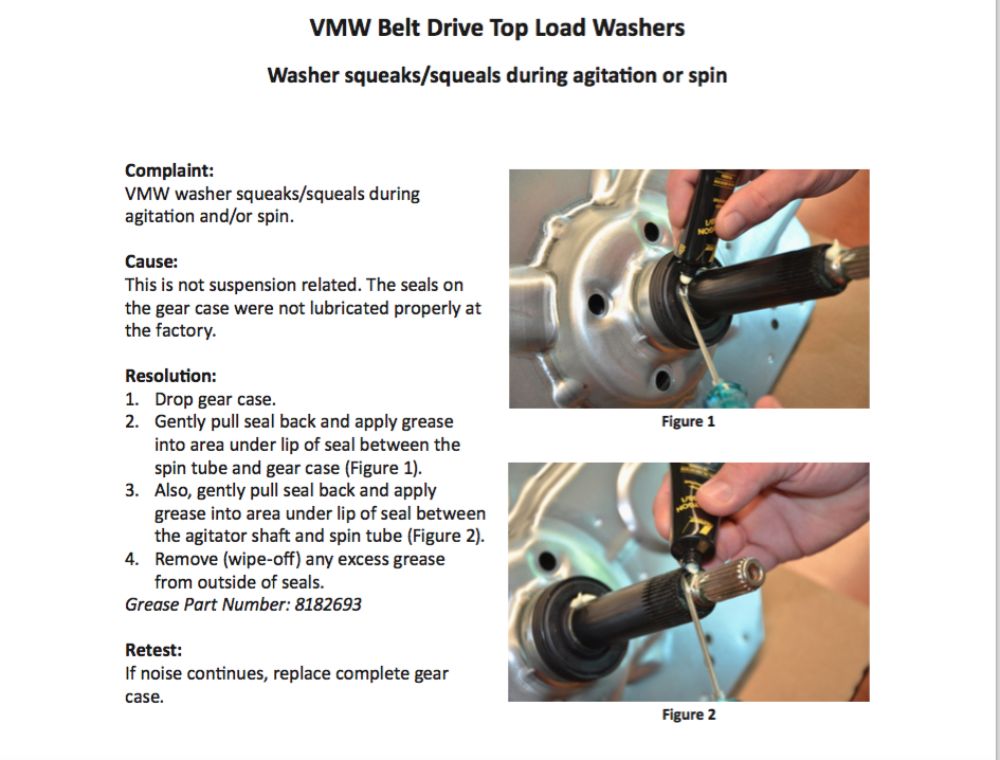
Identification:
First, where is the sound coming from?
Now:
If it’s coming from beneath the drum and is not related to any external component, the transmission should be your prime suspect.
Next:
Locate the transmission and the tub seal for a closer inspection. If you have a vertical modular model from any brand, here’s how to access them.
Check if the tub seal is worn out and proceed to the transmission.
Here’s a pro tip from Jake:
“One way to troubleshoot the transmission is to give the shaft a manual twist. If it squeaks, you’ve found the troublemaker.”
Finally, check if there is any oil leak at the bottom of the washer or on nearby components.This is another symptom of a failing transmission.
Note:
Even if the transmission is leaking, the actual squeak culprit might be the drive belt. When it gets slippery, it’s bound to squeak.
Solution:
Start by applying grease to the tub seal and running a spin cycle to see if the issue will be resolved.
If the noise doesn’t go away, the problem could be the transmission, and in that case, you will have to replace it.
Pro Tip:
“Check your warranty. Transmissions are usually covered for at least one year,” Jake advises.
If you’re out of luck, do the math on repair costs versus investing in a new machine.
4. Loose or Misaligned Rotor
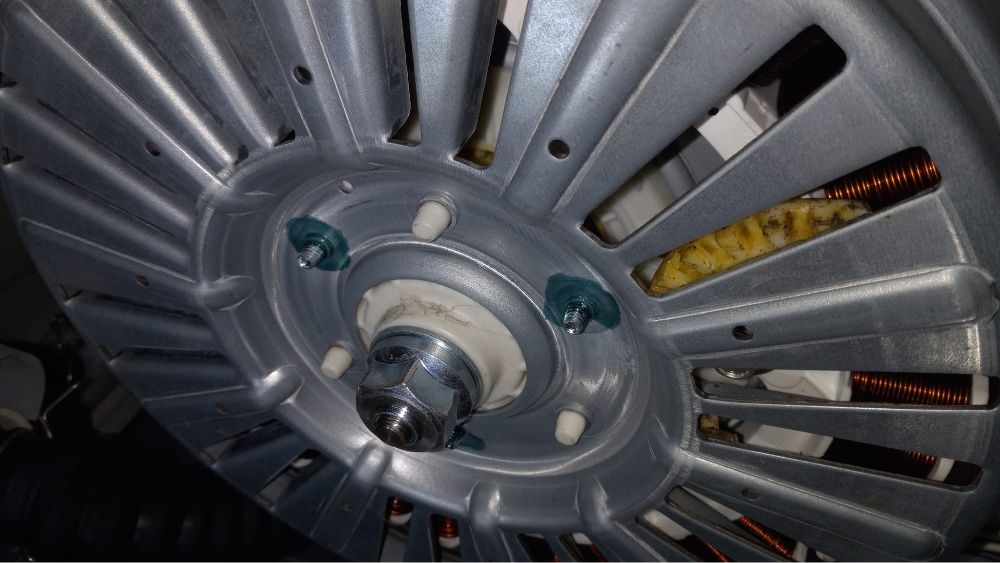
| Part | Rotor |
| Location | Bottom or back Note: Only found on direct drive washing machines |
| Ease of troubleshooting | Hard |
| Replacement part cost | $100-$200 Most of the time, no replacement is needed. |
| Repairable | Yes |
Problem:
Another potential culprit that I have encountered a couple of times is a loose rotor.
As Jake explains,
“The rotor and stator are parts of the motor assembly on direct-drive washers. When the rotor rotates it creates a magnetic field that drives the motion of the drum or the agitator.”
Now:
Just like with transmissions, worn-out or failing bearings in the rotor assembly can result in increased friction and squeaking noises.
Other times, the rotor could be loose, misaligned, or slipping off the stator. For instance, this user’s LG front load washer was squeaking because the rotor was loose.
Sometimes:
There could be a loose non-magnetic object around that area.
Identification:
First up, locate the rotor.
If you’re team Whirlpool, KitchenAid, or Maytag with a direct-drive model, it’s probably at the bottom. For front-load washer models, it’s usually located at the back.
Now:
With the washer unplugged, remove the rear panel or bottom.
Next:
Inspect the surrounding components for obvious issues like scratches, misalignment, or a stuck object.
Finally:
Do a bolt check. Make sure that the rotor and attachments connected to it and the stator are tightly secured.
Solution:
If you find that the rotor is loose, use a socket to tighten the nuts. But if it’s beyond saving, then it’s time for a replacement.
5. Problem with the Agitator
| Part | Agitator |
| Location | At the center of the tub in top-load models |
| Ease of troubleshooting | Easy |
| Replacement cost | $10-$50 |
| Repairable | No |
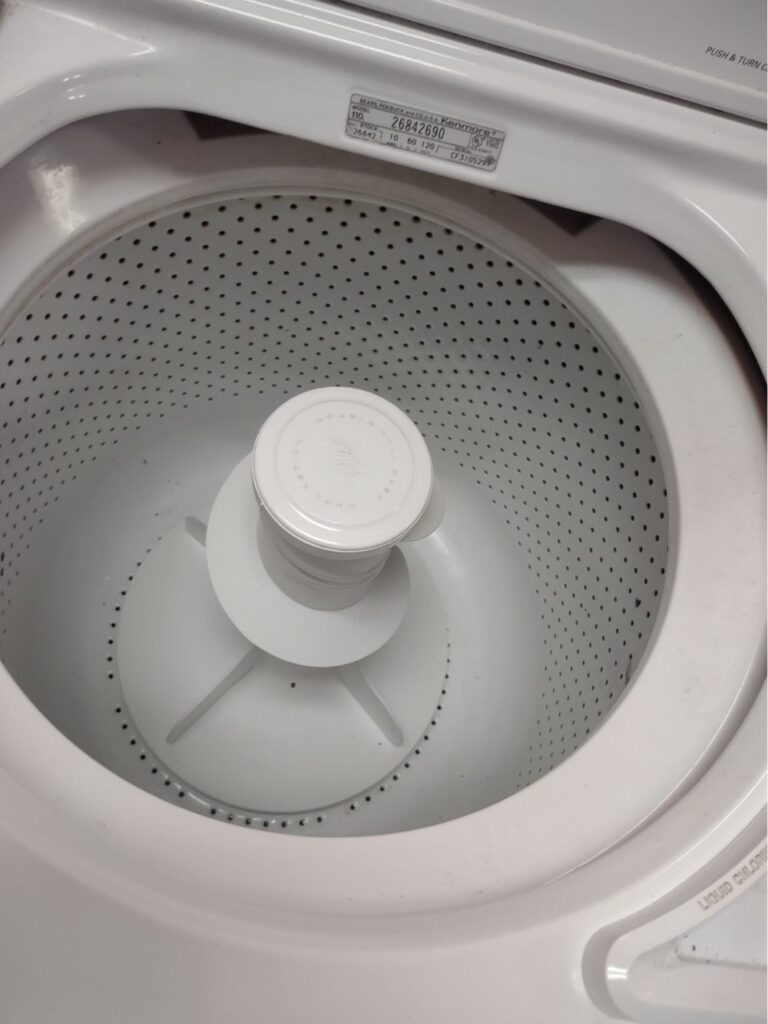
Problem:
Now:
If you have a top-load washer with an agitator, it could also be the source of the squeaking noise.
As Jake rightly puts it,
“Mostly, the problem isn’t with the agitator itself but rather with one of the smaller components, especially the cam and the dogs.”

Other times:
A small object like a coin or button can get trapped under or inside the agitator. Such objects can produce a squeaking noise as they get moved around.
Identification and solution
First off, give your agitator a manual spin. If it squeaks, you’re onto something.
Next:
Take out the agitator and run a quick cycle. If the squeaking stops, you’re probably staring at the culprit.
Now, grab a socket wrench and unscrew the agitator’s central bolt to take a closer look. When it’s out pull out the upper part to inspect the cam set.
Now:
If you find a damaged dog or cam, grab an agitator repair kit and replace the set.
6. Worn-Out Motor Coupling
| Part | Motor coupler |
| Location | Between the motor and the transmission |
| Ease of troubleshooting | Medium |
| Replacement cost | $10-$50 |
| Repairable | No |
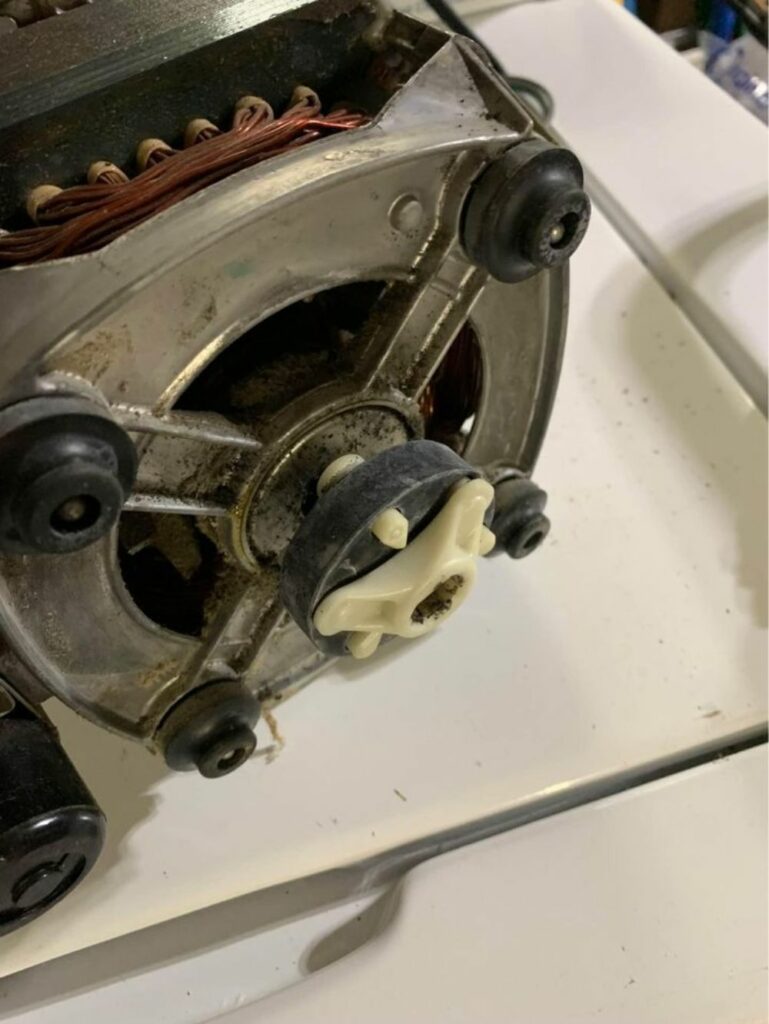
Problem:
“The motor coupler serves as a safety device that protects the motor from breaking apart if the transmission fails,” Jake explains.
However:
Since it’s made up of plastic bits it’s susceptible to wearing down, which results in the squeaking noise.
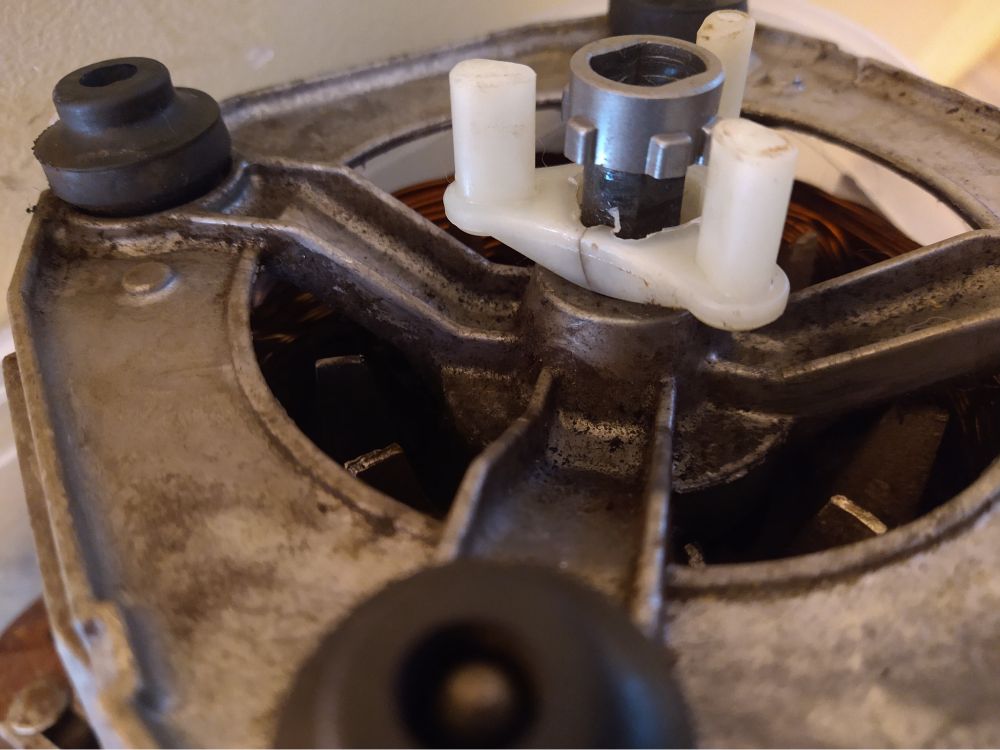
Identification and solution
Now:
One sign that the coupler could be causing the squeaking is if it occurs when the machine switches from one mode to another.
Why?
That’s the time when the motor coupler is usually engaged.
Also:
The sound will be coming from the bottom of the washer, where the motor and transmission are located.
Lastly:
There may also be rubbery dust on the floor.
Now:
To inspect the motor coupling, you’ll need to hunt it down. Usually, it’s attached directly to the motor’s shaft.
“Since it comprises of two plastic components and a rubber middle piece, it’s pretty easy to troubleshoot,” Jake comments.
If any part looks worn or damaged, it’s time for a replacement.
7. Defective Clutch
| Part | Clutch |
| Location | Between the transmission and the agitator Note: Only found on top load washers with an agitator. |
| Ease of troubleshooting | Medium |
| Replacement part cost | $20-$100 |
| Repairable | No |
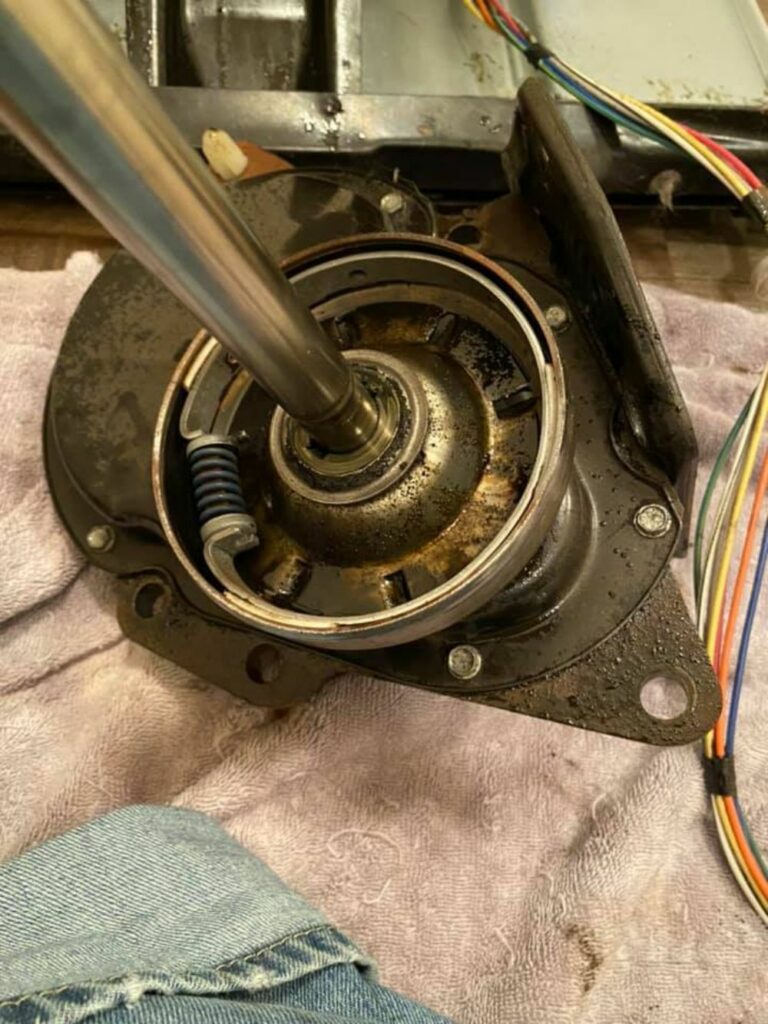
Problem:
Got a top-load washer complete with an agitator? You might want to take a closer look at the clutch.
“In top-load washers, the clutch is what lets the washer transition between washing, spinning, and rinsing,” Jake explains.
But guess what?
Over time, the clutch’s inner lining can wear out, leading to a squeaking or squealing noise.
Sometimes:
The clutch assembly can get misaligned, perhaps due to rough movements. Therefore, it might not engage and disengage smoothly, causing a squeaking noise.
Identification:
So, how do you know it’s the clutch causing the squeaking?
According to Jake,
“The first sign that the clutch could be the culprit is if the noise is happening when the machine is transitioning between the agitation and spin cycles.”
To further investigate, turn off and unplug your washer, then manually rotate the drum. If you can hear a squeak or feel resistance, it might point toward a clutch issue.
Time for a close-up
Here, locate the clutch assembly for a close inspection. For most washers, It’s usually attached to the transmission shaft.
Yep, this means you’ll have to do a bit of disassembly, starting with the agitator and moving on to the transmission assembly at the bottom.
Solution:
If your inspection reveals a worn-out or damaged clutch, replacing it is typically your best bet.
8. Suspension Rods
| Part | Suspension rods |
| Location | Outside the tub on each corner. Running from the top of the cabinet to the bottom corner of the tub. |
| Ease of troubleshooting | Medium |
| Replacement part cost | $20-$100 |
| Repairable | No |
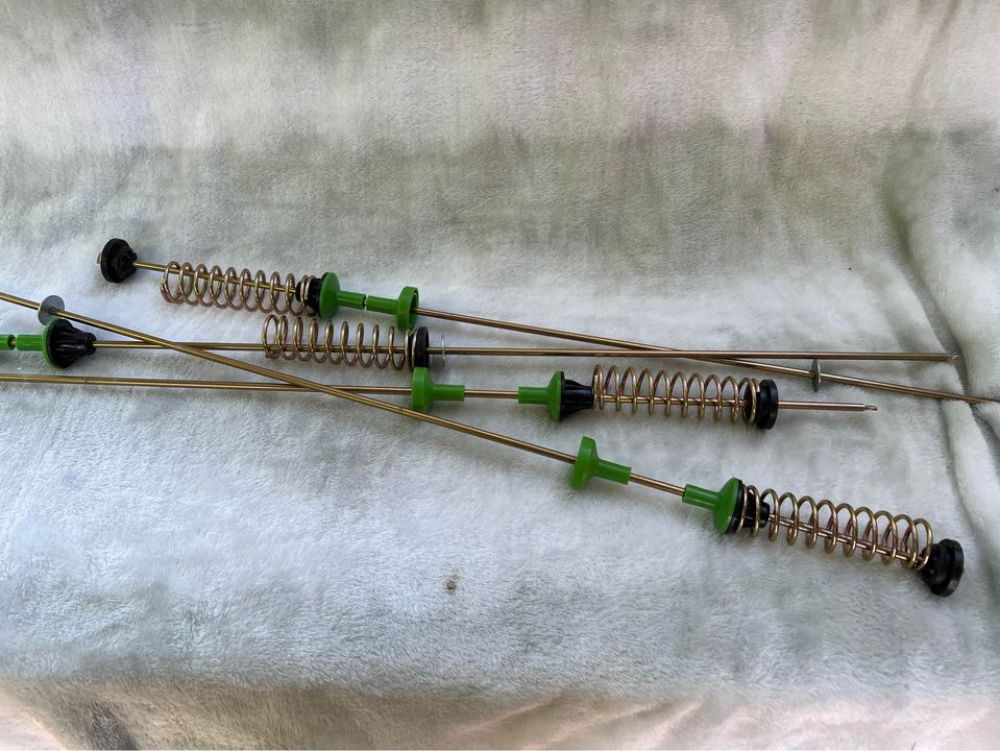
Problem:
Last on our list of squeak suspects: faulty suspension rods.
As Jake points out, “These rods help to stabilize the tub and absorb vibrations during cycles.”
Now:
Typically, you’ve got four of these, running vertically and connecting the machine’s frame to the bottom of the tub.
Here is the thing:
“If one or more suspension rod is worn out, misaligned, or damaged, it can cause various noises, including squeaking,” Jake expounds.
Identification:
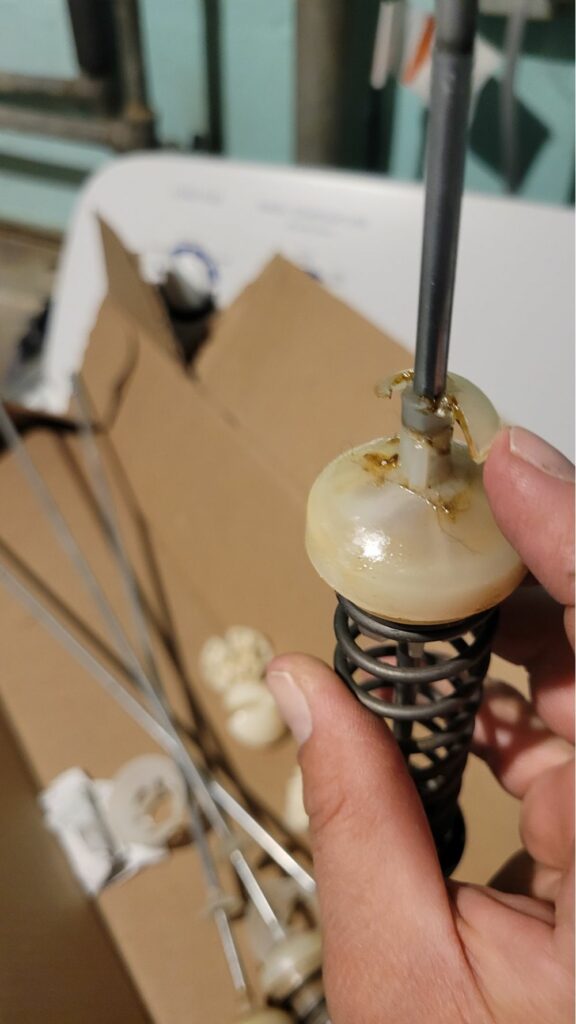
First cue:
If the washer is shaking more than usual, it’s an indication that the suspension system might be failing.
Now:
To test the rods, push down and release the tub when the washer is empty. A functional suspension system should quickly stabilize the drum
Also:
Check carefully if the tub is sagging or tilted. That’s a sign that the suspension rods aren’t effectively holding it up.
Here is the thing:
A sagging drum could result in metal-on-metal contact between the drum and other parts such as the body.
This contact can produce squeaking or scraping sounds.
Now:
The final step is to locate the suspension rods for inspection.
To get a good look at those rods, open up your washer’s cabinet or back panel.
Here:
Look for any signs of wear and damage.
Solution:
If you’ve identified the rods as the problem, replace them and run a test cycle to confirm whether the rods were the issue.
Other Causes
Below are a few more causes of the squeaking problem.
- A loose object inside the inner tub.
- Overloaded or unbalanced washer.
- A stray object stuck between the tubs.
- High water pressure during filling.
- Faulty shock pad.
- Damaged basket drive kit.
- Worn tub bearings.
- Faulty top apron support assembly
- Malfunctioning drive motor
- Unlevel installation
Conclusion
So there you have it—your top suspects for a squeaking washer. Just to recap, you could be dealing with any of the following culprits:
- Damaged drive belt
- Faulty transmission
- Damaged tub seal
- Faulty clutch
- Worn-out agitator cam or dogs
- Loose rotor
The key to cracking this case is timing and location. When does the squeak happen, and where is it coming from? Once you’ve got that nailed down, you’re halfway to solving the mystery.
Still stumped? Consult a pro or ask for help in our Facebook Repair Group.

